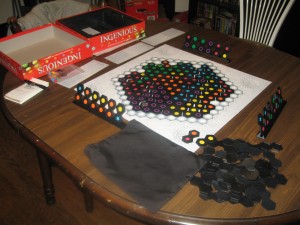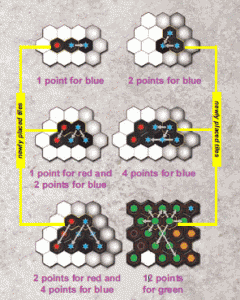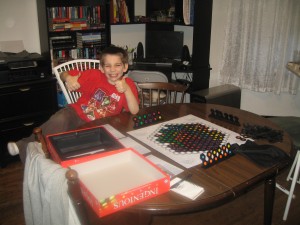I honestly didn’t think that matching colored shapes would be fun. I was genuinely surprised by how deep this game is while managing not to lose its simplistic innocence.
You’ll notice right away that Ingenious is sharp and colorful. The game comes with a velvet bag of playing tiles, a set of racks, a playing board, and set of cardboard scoring sheets and pegs.
Each player receives a rack and six tiles. The tiles are kept hidden from the other players. Players also receive a scoring table and one colored peg for each column, representing their score for each colored shape.
The board itself is hexagonal in shape. You’ll also notice that the areas on the two outside “rows” are shaded two different colors and the majority of the board (the inside) is white. Two players will use the spaces in the white portion only, three players will include the spaces in the second to last shaded area, and four players will include ALL spaces.
There are six different colored shapes in this game. As players lay their tiles on the board, taking turns, one at a time, they’ll be scoring (moving) the appropriate colored pegs on their scorecard. The amount of points you get is based on how many not only border the same colored shape you just placed, but how many are matched up in a row. Players do not count the colored shapes that they just placed as part of the score.
For example, if there were four purple circles in a row and I placed a tile that added a fifth purple circle to that row, I’d score four points plus whatever other colors bordered that tile that were of the same color. If any of those had a row of tiles of the same colored purple shape, I’d score those too.
You perform the same scoring procedure for the other hex on your tile, you score your points, and the turn ends. If you manage to get any one of your colors up to 18, the highest on your scorecard, you get a free turn.
Here’s the kicker…your final score is NOT the combined total of all of your points from the six columns of colored shapes…it is whatever the LOWEST score you have showing in one of the columns. If you had 15 red, 14 blue, 12 green, 18 orange, 15 yellow, and 2 purple…your final score would be 2.
This opens up a bit of strategy…do you try to focus on one color and quickly build it up or focus on some or all of them at once and slowly build them up? Also, if you see your opponent(s) has a low score of one color, you could try to place your tiles in such a way that cuts off everyone from connecting to it.
The hardest part of this game is getting used to the scoring mechanic. Once you are onboard with it, it takes maybe five seconds to add everything up. Annoyingly, moving pegs on your scorecard can be a chore for fat fingers…I personally do away with the pegs and keep track on paper. I simply write down the player’s name and assign one line of each color going down. As players score on a color, I’d add the points to the existing number, write down the sum, and cross out the old number. One of these days I plan to create an Excel sheet anyone can print out and use.
I highly recommend this game for its simplicity and strategy factor. It also happens to be one of the most requested in the house by the thirteen and ten-year old when we hold a game night. It may not appeal to hardcore gamers that prefer spending entire weekends playing Risk, but for families looking for an easy game to play on game night, you can’t go wrong with Ingenious.
Final Verdict: 9/10
—
Related Links:
—




Thank you for putting your score card in a PDF, it is so much better than moving the little pegs. I appreciate it very much!!!
Your description on how to play Ingenious on You Tube is excellent. So glad you mentioned your scorecard in your video. At that time,
I didn’t know I would need it but the first time we played the game one of the pegs hit the floor and the dog ate it. Thank you! I appreciate you sharing it.
Glad I could help!